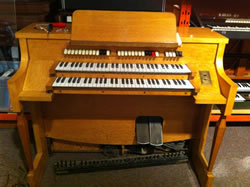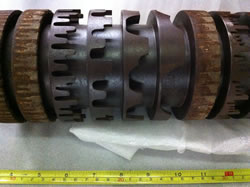Frank Morse Robb’s Wave Organ
The world’s first electronic organ
The Robb Wave Organ
Canadian Frank Morse Robb of Belleville, Ontario created the world’s first electronic organ in 1927 (Kallmann 2014). His stated aim was to produce an electronic replacement for the pipe organ. However, due to manufacturing and financial difficulties, it is believed that only 16 to 20 instruments were built, and until recently it was thought that no examples survived.

Newspaper reports and critical response to the organ were very favourable. William Harrison Barnes reported as late as 1937 that, when comparing it to the Hammond Organ, “some of the tones were equal to good [pipe] organ tones, and a better Trumpet quality was obtained than I have heard on any other electronic” and “the attack of the tone was much more like that of an organ than either the Hammond or Orgatron” (Barnes 1937, 356). The authors were intrigued as to the possible reasons for the “better tones” and positive reviews, and have endeavoured to investigate the approach used by Robb. Fortunately, a partially-working Robb Wave Organ (circa 1936) was recently discovered and donated to the National Music Centre in Calgary (Alberta, Canada) and has been made available to the authors for analysis.
Sample-Based Synthesis
Robb was among the first inventors to utilize sample-based synthesis (Murphy and Kupp 2013). Neither of the two other organs mentioned by Barnes utilized a sample-based synthesis process: the Hammond employed an additive synthesis process and the Orgatron relied on an electrostatic system (Bush and Kassel 2006, 168). Sample-based synthesis is a well-known technique for reproducing natural musical instruments by manipulating a library of sampled sounds. It is generally contrasted with other techniques such as additive and subtractive synthesis, and has become a widely used music technology thanks to the evolution and reduced cost of computer-based memory and processing power. It is popular belief that viable sample-based synthesis tools and methods historically followed additive and subtractive synthesis by some 30 years. With the discovery of the Robb Wave Organ’s sampling technology, the authors were excited by the prospect of potentially disproving this belief and shedding new light on the origins of sampling.
“Digital” Sampling?

Robb’s patents explained his plan to create and reproduce samples by capturing complex waveforms of pipe organs on an oscilloscope and photo-mechanically transferring the samples to spinning metal tone wheels by cutting in the smooth “analogue” waveforms (Robb 1927).
Through the authors’ examination of the surviving organ, they discovered that, by 1936, the tone wheel design had further evolved into a slotted tooth style. The tone wheels appear to be cut in what we would recognize as a digitized, almost Pulse Code Modulation (PCM) scheme. As this was fully a year before Alec Reeves conceived of PCM, and about a decade before Oliver and Shannon’s PCM patent (Deloraine and Reeves 1965), it is not yet clear how or why Robb elected to modify his design.
Bringing the Organ Back to Life
Challenges
The researchers next embarked on a plan to recreate the entire organ sound palette, including individual stops and pedal sounds (Murphy and Cotter 2014). The goal was to create a sample set that would be able to reproduce any sound the original organ was capable of generating, using a two-manual keyboard arrangement as well as a pedal board.
Creating a Sample Set
The original controller was available but the umbilical cabling to the tone generation module had been severed. Because circuit diagrams and other documentation were sparse, the authors needed to take a different approach to tease out the subtle individual stops of the organ. In addition, the organ electronics are in a bad state, with many of the original hand-wound relays requiring replacement or repair. Clearly, a conventional restoration of the organ would be a painstaking and time-consuming process. As this is the only known surviving example, it would be highly desirable to have the organ eventually fully restored for historical purposes. However, a full restoration was beyond the resources available to the researchers.

The researchers decided to take an incremental approach using digital sampling tools. Fortunately, the mechanical tone wheel mechanism of the organ is very robust, being manufactured to very high tolerances and using an automotive-style oil sump for bearing lubrication. In addition, the individual electromagnetic pickups all appeared to be in working order.
Figure 3 shows one of the twelve rotating tone wheels of the organ. Each wheel represents one note in the chromatic scale across all octaves (in this example “D”). Different notes across each octave are generated by the number of “slots” spinning past a pickup. The pickups are arranged to generate different fundamental frequencies as well as the various upper harmonics of the sampled waveform. The organ control circuitry would normally be used to add and subtract various pickups to respond to the selected organ stop(s) as well as the octave of the note being played.
As we were unable to rely on the control circuitry, each individual pickup was sampled in isolation. This resulted in the creation of a master digital sample super-set.
Sample Clean-up
A total of 384 raw samples were digitally recorded (Pro Tools HD) by directly connecting to the pickup using a transformer-based direct-input (DI) box. Most of the samples were of usable quality. A few were unacceptable due to noisy or damaged pickups, and while these were retained for authenticity, the worst offenders were replaced by interpolating and pitch-shifting adjacent samples.
The samples were finally trimmed to one-second loops and all were painstakingly edited to remove DC-offsets and cut to zero-crossings to ensure seamless looping. The samples have been packaged into several popular sampler formats (ESX24, Structure, HALion, Ableton, Kontakt, etc.) and will be uploaded to the authors’ web site for free download and audition by the general public.
The “Flora” Stop
One stop on the Robb Wave Organ was of particular interest, as it is not a conventional pipe organ stop. Further research revealed that Robb created the “Flora” stop by using the voice of Lady Flora Eaton as the basis for the sample (Keane 1984). Lady Eaton was an investor in the Robb company (Kallmann 2014) and Robb intended this flattery to be an example of future marketing potential, allowing wealthy clients to have their organ personalized by creating custom stops based on the voice of a loved one.
Recreating and Matching the Stops
Determining which sample combinations corresponded to the original stops proved to be challenging without access to definitive schematics. One available document contained some hand-scrawled notes that provided hints. Eventually, various sample combinations were sonically compared to traditional pipe organ stops. As a veracity test, the authors consulted several texts and organ sheet music indicating the use of different stops (Truette 1919).
Results
The approach taken has resulted in the recreation of a useable sample set of the Robb Wave Organ, which will soon be available to the general public for download on the AccessFabrik Lab website. The contribution of Robb to both electronic organ development as well as early sample-based synthesis can be better understood by hearing the organ once again. It is remarkable that such a technology was developed in 1927, and these samples allow a contemporary audience to better appreciate the significance of Robb’s achievement.
Future Work
The authors intend to further analyze and research the digitized, almost Pulse Code Modulation (PCM) scheme used by Robb in his evolved instrument. They are also building a replica Robb Wave Organ console that will contain a “MIDI-fied” pedal board and manuals to trigger their sample set from an internally housed computer running Hauptwerk, an organ sampling software.
Acknowledgements
The authors gratefully acknowledge the generous support of the Ryerson University Faculty of Communication and Design SRC Committee (Toronto), the Ryerson University Creative Fund (Toronto), the The National Music Centre (Calgary) and the Canada Science and Technology Museum (Ottawa).
Bibliography
Barnes, William H. The Contemporary American Organ. New York NY: Fischer, 1937.
Bush, Douglas and Richard Kassel. The Organ: An Encyclopedia. New York NY: Routledge, 2006.
Deloraine, E. Maurice and Alex H. Reeves. “The 25th Anniversary of Pulse Code Modulation.” IEEE Spectrum 2/5 (May 1965).
Kallmann, Helmut, “Robb, Frank Morse.” The Canadian Encyclopedia. http://www.thecanadianencyclopedia.ca/en/article/frank-morse-robb [Last accessed 18 March 2014]
Keane, David, “Electroacoustic Music in Canada: 1950–1984.” eContact! 3.4 — Histoires de l’électroacoustique / Histories of Electroacoustics. https://cec.sonus.ca/econtact/Histories/EaMusicCanada.htm [Last accessed 18 March 2014]
Murphy, Michael and Max Cotter. “Recreating Robb: The sound of the world’s first electronic organ.” e-Brief 148. AES Convention 2014. Convention e-Brief.Proceedings of the 136th Audio Engineering Society Convention (Berlin, Germany: 26–29 April 2014).
Murphy, Michael and Eric Kupp. “An Examination of Early Analog and Digital Sampling — The Robb Wave Organ circa 1927.” Convention e-Brief. AES Convention 2013. Proceedings of the 134th Audio Engineering Society Convention (Rome, Italy: 4–7 May 2013).
Robb, Frank Morse. “Sound-Reproducing Instrument.” US Patent 1,785,915 filed 29 September 1927, issued 23 December 1930. http://www.google.ca/patents/US1785915 [Last accessed 19 March 2014].
Truette, Everett Ellsworth. Organ Registration: A Comprehensive treatise on the distinctive quality of tone of organ stops. Boston MA: C.W. Thompson, 1919.
Social top